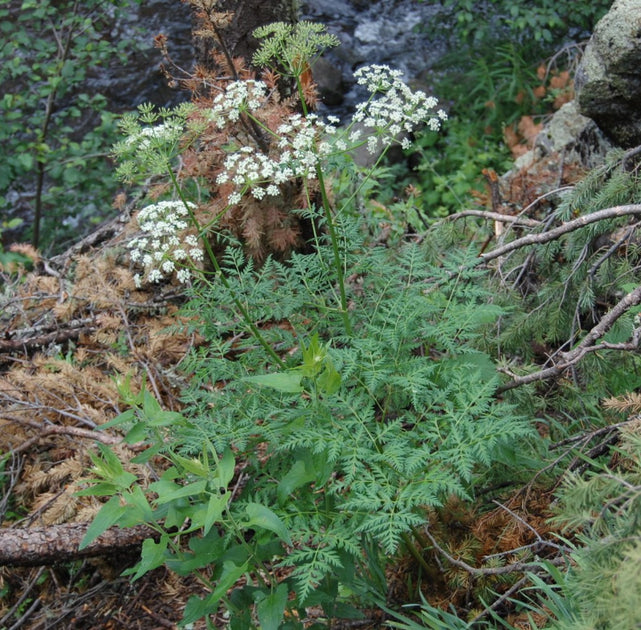Ligusticum porteri – Chuchupate, Oshá
Other Names: Bear Root, Colorado Cough Root, Chuchupate, Hunawpi, Nawpi, Wasike, Shush, Chuchupaste, Porter’s Lovage
Origin: Chuchupate is found primarily from the Rocky Mtns. south down into the Cordillera of Mexico. Widely used by peoples of the Southwest and Mexico with a far-reaching significance in their cosmology. The plant is greatly varied in terms of size, scent, growth characteristics, and adaptability to environment. It is not grown commercially, but is prolific in the mountains of Colorado, primarily SW Colorado.
Energetics: Hot & Dry. Pungent, spicy sweet, bitter. Vital Stimulant. Tonic.
Properties: Stimulating diaphoretic, stimulating expectorant, circulatory stimulant, antiviral, carminative, aromatic bitter, digestive, antimicrobial, styptic, anodyne, antiseptic, emmenagogue
Uses: Cough, sore throat, colds, influenza, bronchitis, fever, empacho, indigestion, injured joints/tendons/ligaments, bruises, toothache, snake bite, wounds, stings, or spider bites.
Ligusticum porteri – seedhead
Appearance, Habitat & Poison Relatives
Ligusticum porteri has opposite or whorled flower stems making umbrellas of white flowers. In the heart of the summer you can find these Queen Anne’s Lace-like stately flower stalks rising above all herby perennials in the forest and at clearings making them clearly visible from roadsides. I always find it growing in stands; within Aspen groves, with Douglas Fir, Firs and Spruce, rarely with Ponderosa Pine or Gambel Oaks. You are far more likely to find it in abundance above 9000’ even though it can be found down to 5500’ on occasion. It’s often associated with Valerian, Pedicularis spp., Maianthemum spp., Poison Hemlock, Yarrow, spritely deer and elk, and a variety of fungi. Rarely, I have found Oshá growing in loose, sandy soil making the dig a rather quick and enjoyable walk in the park. However, it often grows in impacted soil interlaced with tree roots causing the careful digger to spend several hours hunched over surgically pruning and extracting large root masses. More on this to follow.
Ligusticum porteri – Leaf
A concern for many is its resemblance to nonnative, Poison Hemlock, Conium maculatum. The truth is these two plants rarely grow together and they can easily be distinguished upon close inspection. Nonetheless, I have found very little (if anything of note) to distinguish these two plants by leaves alone. The situation you will likely find them growing side-by-side in is a small high mountain drainage, perhaps even growing in the water. This locale is somewhat common for Poison Hemlock but rather unusual for Oshá. To clearly identify, dig away at the base of the plant until you reach the root crown (may be several inches) and you will pick up the strong celery-esque scent of Oshá from the root crown but little to no scent from Poison Hemlock. You will also find the previous year’s remnant stalk fibers still attached to Oshá’s root crown, whereas nothing will be attached to the Poison Hemlock root crown. Additionally, Poison Hemlock often appears as an annual throughout the Southwest, whereas Oshá may live for several decades. An aboveground identifying factor of Oshá is that it has rounded seed heads and not a flat profile, like Poison Hemlock – these are the most poisonous part of Poison Hemlock so don’t taste test the seeds. There is also an indescribable visage to Oshá that becomes apparent the more time you spend with the plant.
Gathering and Medicine-making
As is the case with nearly all plants, Oshá comes in varieties. I don’t mean botanical varieties, per se, (although there are subspecies) but qualities clearly discernible from distant mountain ranges, or within different soil types, creating unique chemical races with various tastes and tissue effects when used as medicine. I have tasted at least 5 varieties throughout the Southwest by taste alone. These come in gradations with certain qualities being more prominent in certain populations leading to various permutations of the distinct Oshá qualities. Such is life, such is the flow of Nature. A regional herbalist can attune to these properties, within a certain context, a place in time, moving with the flow of Life around him/herself, bringing it all together for those who seek help in their path towards healing. Oshá’s taste is primarily and consistently spicy pungent, but it can have a degree of sweetness that is pronounced throughout the various isolated populations of the southwest. The root is of primary concern with Oshá and it is what you’ll find at your local herb store (perhaps) or in commerce. The seeds (like Angelica spp.) have particular value, but are nowhere near as potent as the root for all the classic uses – expectorant, diaphoretic, immune-stimulant, antiseptic, blood mover – and the leaves are of food class and they lose potency quickly upon drying (similar to related Cilantro). It is something of a talisman across cultures – even amongst people who live hundreds and hundreds of miles from where Oshá grows! The root is used in ritual offerings, as protection, to ward off evil forces and malicious creatures, and as a first-aid medicine. Generally, the roots are harvested in the late summer once the leaves of the plant have begun to turn yellow (often well before any other plants do so making it easily distinguishable within the forest). I have also witnessed that some groups harvest the plant when it first emerges in the spring. To my mind this makes a lot of sense as the medicine of the plant (and all of its vital force) has been stored within the root over the long winter time (this plant is an herbaceous perennial so there’s no woody aboveground parts) and is only now beginning to emerge aboveground. Beautiful. This is certainly a time when bears are known to dig it up to “cleanse” their systems and kickstart their metabolism in the spring. Apparently, there is some difference of opinion, and practice, within the herbal community as to how the root is to be harvested and when. I’d like to discuss this a bit . . . I first learned to identify and harvest Oshá within the high elevations and rich montane groves of southwestern Colorado. Here it is a prolific species and can cover forest floors to such an extent as to warrant stepping on the Oshá just to make it through an area! Here you can also find certain habits of growth that are not found elsewhere – certain habits cultivated (no doubt) by the rich soil and more importantly the abundant moisture (15’+ of snow and 2’+ of rainfall, annually). Pictured above you can see at the base of the reddish stems a clump of soil stuck onto a root crown of Oshá. Coming out from below the clump of soil is the main tap root. This habit is something like a carrot (same botanical family) but different in that it can shoot of numerous rootlets along its length, several being 1” in diameter. So a mature plant (20 years?) can produce several pounds from one root mass (not including the root crown). However, in these particularly wet high montane forests of Colorado and Utah one can find the roots (more like rhizomes) criss-crossing and interconnecting just 1-4” below the surface of the soil in a maze of complexity creating tremendous root mass over an area 1 meter square. AND these roots/rhizomes are often quite young as evidenced by the space of several inches between their root nodes (think of the space between your finger joints). In such cases, I like to gather as much of the creeping root mass I can find within a given area I dig up while leaving the root crown intact. This root crown is identified by the appearance of thin root “hairs” rising upward at the base of the stems. In fact, these “hairs” are remnants of previous years’ stems, and they are one of the chief identifying characteristics of Oshá (along with its characteristic spicy celery scent). I have practiced leaving the mature root crowns in the ground for several years now. For plants which dig tap roots deeper into the Earth I like to coppice the long, thin rootlets and tap roots while leaving the root crown to re-grow. We are currently observing a small group of specific plants to see how these plants respond to different harvesting techniques. We hope to find a way to interact with the wild plants, harvesting our needed medicines, while cultivating a healthier stand through our interventions. I truly believe that many plants appreciate when we harvest them, or from them. If we pay close attention, quiet ourselves and listen we can learn how to do this in the most advantageous way for all involved. I believe this cultivates deeper relationship with the plants and brings greater potency to the medicines we make from them.
Young Chuchupate
Oshá is a wonderful plant to make medicine with. It’s smell is spicy-sweet and carries the cool, crisp vibrancy of the montane forest. There’s a solace in its aroma, accompanying me as the cool early-autumn night descends with an amber sunset and its warmth sends blood moving throughout my body leaving me feeling invigorated and full, yet content.
I have come to love a raw honey extraction made with the fresh root. This is set aside to soak for several months before straining. Then we have two medicines – the root “candy” and the honey infusion. Both are fantastic for sore throat, hoarseness, laryngitis, hectic cough, and an immune-stimulant at the onset of infection. We simply chew the root candy and usually a finger tip of the honey is sufficient to bring a voice back or soothe a hot, irritated sore throat.
Additionally, a fresh plant tincture is a wonderful representation of the root’s medicine. Some folks don’t enjoy chewing the root and the tincture can be added to many formulations (cough syrup, oxymel, tincture formula, etc.) so we always try to keep some on-hand. I have made tincture from the dry root when necessary, but I do prefer it fresh as it is more heating. If you want to make a tea of Oshá root you will be getting much of the digestive stimulation and emmenagogue effect with some blood moving effect, but much of the immune-enhancing and expectorant qualities are less apparent with a tea. A cold infusion may preserve the aromatic oils best. Chewing the root has been done for millennia. It is my favorite application when I first feel the tinge of a viral infection taking form. The dry root is slowly moistened by your saliva . . . swallow the therapeutic juice . . . cover yourself in a blanket and go to sleep. If you still feel ill when you awaken, do it again. I have recovered from many sudden onset viral infections rather quickly by doing just that. For those who tend to get cold during a fever, Oshá is an excellent remedy.
More on Medicine
Chuchupate Leaf
The root is purported to contain silica (like Horsetail and Oatstraw) lending reason to its ability to help regenerate weakened lung function. Chewing on a piece of the root when at higher elevations is a sure way to feel an empowerment of lung function with increased oxygen utilization throughout the musculature. Whenever the lungs feel obstructed, especially when they feel dry, tight, and cold, Oshá is the herb. If the sinuses are affected combine it with Yerba Mansa (Anemopsis californica). It is a top-notch digestive herb, but so are fennel and coriander (which are a lot easier to obtain). I like the cold infusion or decoction with orange peel and mixing some tincture into an oxymel base (vinegar and honey).I discovered an interesting effect on the eyes with the fresh seed. Eaten fresh or tinctured fresh, the seed stimulates the eyes in some way as to cause an initial irritation followed by enhanced clarity of vision. It does not occur in both eyes, necessarily, but more where the effect is most needed or at the eye with obstructed vision.
Surprisingly, not too much is written on this most valuable plant of the Rocky Mountains down to the Sierra Madre. Although it has developed quite a reputation for fighting viral infections and allaying sore throats, there is yet much more to discover within the full magic of its Nature.
Cautions
The herb should not be used by pregnant women due to its stimulating effect on the uterine vasculature, nor should it be used for extended periods of time by those exhibiting seriously dry symptoms. Also, beware of sleeping with fresh Oshá in your tent when in bear country – they just may want to snuggle up with you.
Ligusticum porteri – Chuchupate
References
Holmes, Peter 2007. The Energetics of Western Herbs, Vol. 1.
Moore, Michael. 2003. Medicinal Plants of the Mountain West.


